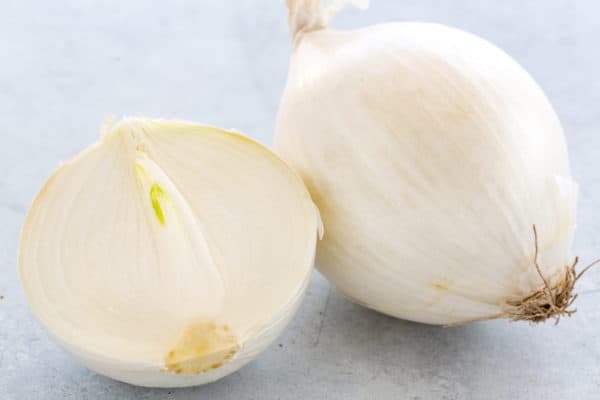The more you cook, the more you realize just how often onions come in handy. Let’s learn more about this vegetable because it’s a flavor staple for the home chef.

Types of onions
Fun fact: Onions make you cry because of the sulfur content. It’s what gives them their flavor, but it’s also what gives them their bite. It’s a sassy vegetable — that’s for sure. There are several types of onions and you can use most of them in similar ways, but they all have their strengths and weaknesses.
Yellow onions

If you had to choose one type of onion to buy, yellow onions are the most versatile. They deliver the most flavor when caramelizing, and you can saute them with (or without) garlic as the base of several dishes. However, they can be overpowering when eaten raw, so leave your burger toppings to the job of a white onion. You can also roast and grill yellow onions.
Try them in French onion soup.
Sweet onions

Sweet onions, as you may have guessed, are sweet. They have less sulfur than other varieties, so they don’t have quite as much punch. They have a slightly different shape as well — more flat and oval than round.
Try them in chicken tortilla soup.
Red onions

While not as sweet as sweet onions, red onions do teeter on the sweeter side of the spectrum because they have more sugar. They taste great in potato salads and on tacos. They are a key topping on BBQ pizza as well. They’re arguably the most bearable type of onion to eat raw. But if you want to cook red onions, have at it.
Of all the onions, it can stand up to the grill best. The sugar also makes them a decent candidate for caramelizing, though it will deliver a slightly different flavor than yellow onions.
Try them in sweet potato hash with eggs.
White onions

Even though they’re pungent and they still make you tear up when you cut into then, they’re easier to eat raw than a yellow onion. That’s why they’re great as a burger topping and in salads. Vidalia onions are actually a white onion, though they’re mistaken as a sweet onion.
Try them in cauliflower fried rice.
Shallots

Shallots can be used just like other onions, but they’re smaller and milder. When you peel them, you’ll likely find a couple of pods in one. While their flavor is more subtle, they still bring a crisp, sharp taste to your dishes.
Try them in steamed mussels.
Scallions (also known as green onions)

Long, thin, and green, scallions look nothing like their other onion family members. They’re flimsier, and they aren’t going to carmelize. You can saute them, but it’s not their strong point and you don’t want to leave them alone on direct heat for too long.
They make a great raw garnish on pasta and rice dishes, and they can be really tasty when mixed with other salad greens.
Try them with bourbon chicken.
Cipollini Onions

These Italian “little onions” are yellow in color and uniquely donut-shaped. They have paper-thin skins with a white flesh that is sweeter than white onions. Due to the higher level of residual sugar, they are great for caramelizing in a saute pan or roasting under high heat. They add a gourmet touch to any meal, and cooking them reduces the sulfurous aroma and astringent bite.
Try them with a classic roasted chicken.
Pearl Onions

These colorful, miniature onions have a sweet and mild flavor. You can find them in red, white and gold varieties. They are great for adding them in peeled and whole in soups and stews, roasting, or pickling. The biggest challenge is how to peel pearl onions. Cutting the end tips, then blanching in hot water for 30 seconds, then shocking on cold water makes the peels come off with ease.
Try them with slow cooker beef stew.
Health benefits
Onions are a good source of potassium and vitamin C. They also have a handful of antioxidants, particularly red onions. Onions are also antibacterial. The especially nice thing about onions is that they pack a lot of flavor and nutrients without running up calorie counts.
What’s the best way to cut an onion?
Always start by slicing off the ends and then halving the onion. This will make it easier to peel. Slit the onion vertically. Rotate the onion and slice again, but this time, as if you were butterflying a chicken breast. Then chop. You can try to minimize onions-induced tears by keeping the cut side down. Though, it’s not a foolproof method.





Premakau says
Jessssica , hi , do you know there is a ‘sambar’ ( a side dish) onion grown in the deep south of India, the size of big garlic cloves… try them on your salads and fish….
Jessica Gavin says
Thank you for the suggestion, I’ll keep an eye out for sambar!
Brad says
Chew on a toothpick. No tears
Jessica Gavin says
I’m intrigued!
Roachman says
Someone told me a trick a long time ago, and it works really well. Always have a mouthful of water as you cut your onions. I don’t know why it works, but it does.
Jessica Gavin says
I am definitely going to try this trick, I’m guessing to prevent you from onion tears?
CW says
I heard if you freeze your onion for about 15 minutes you won’t tear up
Don’t know how true this is-haven’t tried it yet.
Jessica Gavin says
Sounds like a fun experiment to try!